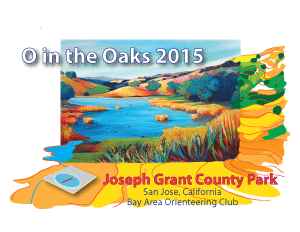O in the Oaks 2015
Joseph D. Grant County Park
Date: Apr. 25 - 26, 2015
Location: San Jose, CA
Event Director: - 408.732.4818
Course Setters: Misha Kreslavsky, Tapio Karras, Matthias Kohler
Type: A; 2-day, combined-time OUSA A-meet with Classic courses
Related Event Information
Main Event Page Event Director's Notes Day-2 Course Setters' Notes A-meet Start Times (https://www.orienteeringusa.org/eventregister/a40/reglist/home/joe-grant-april-2015)
Day-1 Course Setter's Notes
By Misha Kreslavsky
Course Statistics
Course Length Climb Controls Water Stops
White 1.6 km 20 m 1.3% 7 1
Yellow 2.3 km 90 m 3.9% 9 1
Orange 4.4 km 150 m 3.4% 10 1
Brown 3.4 km 120 m 3.5% 8 1
Green 4.3 km 200 m 4.7% 12 2
Red 5.7 km 300 m 5.3% 13 3
Blue 8.2 km 390 m 4.8% 18 3
Safety Bearing
The safety bearing is downhill to Joe Grant Lake, south to Mount Hamilton Road, and to the main parking area of Joe Grant Park.
Warm-up Areas
White and Yellow courses: There is no space available for warm-up near the Start—use the area on your way from the assembly area, before crossing Mount Hamilton Road.
Orange, Brown, Green, Red, and Blue courses: Your Start is 100 m (15 m climb) from the bus drop-off. The warm-up area is to the east from the drop-off and the Start, and not higher than the elevation of the Start. If you need more space for warm-up, use the other side of Mount Hamilton Road (cross it with caution!).
Terrain
The terrain is a mixture of open fields and oak forest. It is beautiful: flowers are blooming, and views are magnificent (especially, on Orange). I've seen bobcats, coyotes, deer, pigs, ground squirrels, turkeys, quails, hawks, vultures, snakes, etc. (but don't be disappointed if they are all hiding during the event).
The steepest slopes are difficult to run in any direction. The grass is rather short, except for some north-facing slopes. Streams are mostly dry, but their rocky beds are very visible. Artificial water channels are also dry.
Map
The scale is 1:10,000; the contour interval is 5 m. For coarse reading, the map is accurate, except for trails. There are many unmapped seasonal cattle trails—some of them are very distinct.
A green O indicates a lone tree (oak) in open terrain, a green × means a dead tree, either standing or fallen. There is the usual ambiguity with lone trees: 2–4 oaks can be shown as either 2–4 lone trees or a copse (white patch). I did my best to remove ×'s that have disappeared, and downgrade O's to ×'s where appropriate, but I might have missed something. Many fallen trees are not mapped.
A non-standard symbol, green cross-hatching screen over white or yellow background, means dense short bushes, usually sagebrush or poison oak. No sensible routes cross those areas.
Hazards
There is poison oak on all the courses, except White. The usual precautions are needed. I do not recommend shorts.
Ticks are in season. Repellent might be a good idea; check-up after the course is imperative.
There are cattle in the park. The park brochure says "They are not aggressive by nature; but, if aggravated or threatened, can respond in a potentially dangerous manner. Try not to startle the cows. Keep your distance and walk around groups of cows rather than through them; don’t get between a calf and its mother."
Horses might be met on trails. You must give them right-of-way. Leave the trail and run well around. Be careful not to suddenly appear on a trail near a horse.
Mount Hamilton Road on the southern edge of the map is out of bounds. There are no sensible routes along it.
Course Comments
Do not forget to check the numbers on the controls: a few of them are close to each other. I followed IOF standards: no controls are closer than 30 meters, and controls on similar features are at least 60 meters apart.
White (Easy Beginner) Course
The White course follows trails. You will need to recognize trails on the map, in the terrain, and make the correct turns at the trail junctions.
Yellow (Advanced Beginner) Course
You will mostly follow trails. However, the control points are off trails, and might be not seen or poorly seen from the trails. You need to recognize a number of features on the map, and in the terrain, to choose the correct trail, and to get to the control points.
There is poison oak on the course. Avoid it. If you do not know how to recognize it, learn at your first control: the bushes around the flag are poison oak.
Intermediate and Advanced Courses
The map was made by two different mappers who had different attitude to vegetation details, and the correspondence between different types of undergrowth and different green hatches and shades is not uniform. Since the map was made, poison oak has expanded, which confuses things even more. I made the most essential corrections. Plan your routes in "white" forest and "yellow" meadows—only very short segments through light green shade, and few-meters-long crossings of other kinds of green, might make sense.
Marshes are still slightly wet, but they are runnable. On Green, Red, and Blue, some sensible routes are on marshes.
I noticed map imperfections in some minor topographic details.
There are barbed-wire fences on the courses. On Orange, Brown, and Green, you have a choice of crossing a fence or using an open gate. On Red and Blue you will have to cross fences twice. As usual, be careful; don't jump over—roll under.
For Orange only: At your water control, the water will be in 20 m from the flag, in the shadow under a tree.

